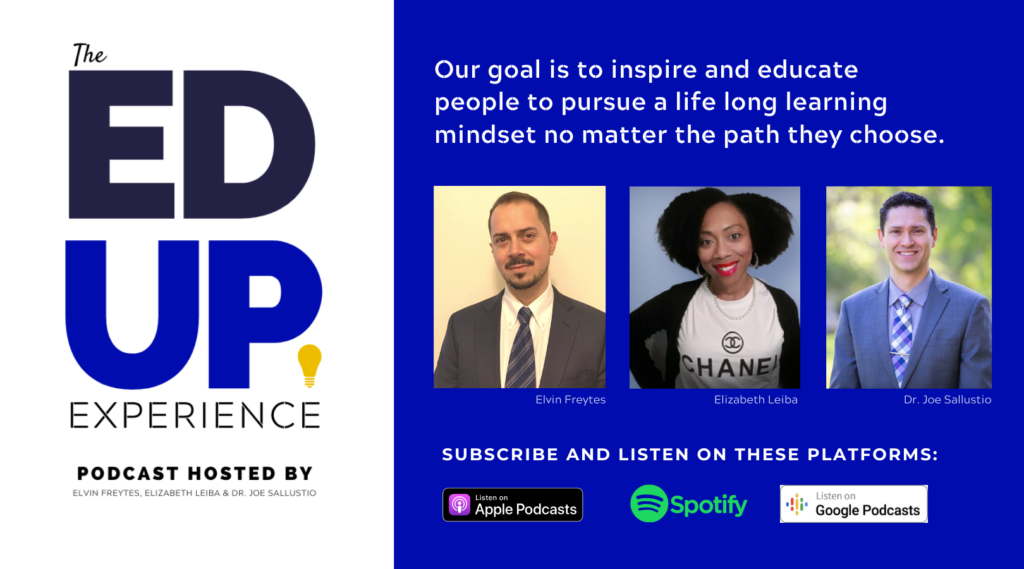Published on
Engaging with Students in Uncertain Times

As the pandemic has impacted institutions financially and changed their infrastructure, they need to focus on what’s most important—the students. By reengaging and retaining learners, institutions can not only be financially successful but also serve their local communities by preparing more people for the workforce. In these times, higher ed needs to reshape their strategic plan to help these students feel connected to the school and encouraged to continue their studies. In this interview, Dr. Joe Sallustio and Elizabeth Leiba speak to Hal Higdon about current enrollment trends, ways to retain students and how to get faculty buy-in for new initiatives.
EdUp Experience: What are you currently seeing with your students and the impact the pandemic has had on them?
Hal Higdon (HH): It’s been an interesting phenomenon. When we first shut down in March 2020, we thought we would be coming back after spring break. And as soon as we could, we brought back all allied health students and technical students to get them into labs to do clinicals and welding or automotive projects. We got them through and graduated in May. Our persistence numbers went up in the spring and summer, and even through the fall.
What we’re finding is that the pandemic has probably put a jet pack on change. What we hoped to do in five years, we’ve done in a year.
EdUp Experience: What are some tips or strategies when learning remotely, and how have your students responded?
HH: We began by going back to the old days; we created a flow sheet and script and called about 11,000 students multiple times. From the initial phone call, there was a flow chart that allowed you to check in with students on any issues they might be facing—physical health, hunger, technical, mental health, etc. We got such incredible feedback—many appreciated the call or told us what they needed.
We have a student emergency fund to which about 80% of our faculty and staff contribute. We were also bringing in donors to help. But that calling campaign paid some dividends. We were at 14% enrollment increase for summer while other schools were dropping. That campaign showed students that we care about them and are there to help. We expanded our live chats to 10 PM every night. Our average student is 20 years old—that traditional age—so they tend to stay up late. After 10 PM we have chatbots, but before then, students are able to speak to a real person.
We’re also embedding advisors into a student’s application. Whichever advisor a student receives on that first day stays with them until graduation. So, that persistence that we’ve been seeing over the past year has been because the students feel connected to the school.
EdUp Experience: With your increase in enrollment, do you think students decided to stay close to home rather than a traditional university? What trends are you seeing?
HH: The trend is interesting. Our allied health programs don’t grow because they’re full. So, they’re static. But general education was up dramatically, which is your academic transfer. And we’re actually down in tech ed. One reason for that is because we’ve had to reduce the number of people in a classroom because of social distancing. But many of our students are traditional aged, and their parents weren’t comfortable with them leaving home with everything going on. So, some of them are earning some credits with us before they go off to university.
EdUp Experience: Will online become a bigger part of your strategy going forward?
HH: Well, I don’t think things will go back to the way to they were beforehand. When we all shifted to the online environment, we assumed we’d hate it. But actually, what we’ve done is create this new group of digital learners. About 50% of our students are Pell-eligible, which means they’re likely working one or two jobs. By taking some classes online, they’re able to manage their school and work lives more easily.
Our community college has always been a buffet. We have technical, allied health and workforce, general education and modalities. And all of these have become hybrid and will continue going forward.
We did an economic impact study just a few years ago, and our economic impact is about a quarter of a billion dollars a year in our region. We have over 40 technical and allied health programs that feed the industry in this area. The one concern would be the decreasing the number of students in Missouri enrolled in our technical programs. We’re in a boom economy and our major manufacturers had advertised on NFL games for people to come out to the workforce. We have a real need for a skilled workforce at a time where we’re seeing a decrease in the number of students going into those fields.
We try to keep in mind that we don’t have a homogeneous student body. The student might be a 20-year-old female from an upper-middle-class family, but there’s also the 28-year-old who just now got their life together and is coming back to school. We also have a huge number of first-generation college students, and that’s a scary proposition. So, we have to be really careful to not put our students in silos.
EdUp Experience: Why do you think silos exist and how are you breaking those down?
HH: We tend to see silos even inside our student affairs area. There’s financial, advising, admission and registrar here. Now, we’re engaged in our student success redesign. If 100 people apply, 50 will enroll and 25 will graduate. We want to change that so that the day you apply, you’ll be contacted by an advisor. Each advisor will have a caseload of 300 to 350 students, and their job will be to get each student to graduation. They don’t work for student services, or financial or academic affairs. They’re completely separate but are trained in financial aid, admissions policies, and transfers.
If a student moves into a different educational field, then they’ll be moved over to an advisor who deals with that section. So, it’s a big investment on our part and that of personnel—many of whom we’ve been able to move around without hiring anyone new—but if this change increases our retention and enrollment rates by 4%, then we will have paid for all the personnel we’re hiring.
EdUp Experience: We’re going to start to see a decrease in the college aged student demographic—how does that effect your strategic planning for the future?
HH: Well, 2026 is a cliff in Missouri. There’s going to be a huge decrease in the number of high school seniors. We’re already seeing the public and private universities who used to be highly selective have relaxed a little. A lot of them used the pandemic as a way to get rid of ACT and SAT testing, but it’s also a strategy because we’re seeing more students admitted into universities who wouldn’t have five years ago. So, top universities are becoming a little more flexible. Schools in the middle are becoming more like four-year community colleges. We’re always going to have the better price point, but what we really want is to give them a better experience.
We’re not a traditional university—we don’t have dorms or athletics, and we don’t plan to. We’re here to teach students and get them on the path to a university or career. That is the future.
We also have to be plugged into our local economy. We can’t have programs that don’t have jobs on the other end. When we look at our 180-day follow-up after graduation, we want to keep 92 to 94% employed in the region. That is extremely important to us. Your reputation is more important in recruitment than active recruitment.
EdUp Experience: What are you seeing in terms of schools looking to widen their top of funnel in terms of applicants to stay relevant?
HH: You’re going to have to stay in business. Over the next five years, we’re going to see hundreds of schools either merge or go out of business. Frankly, states aren’t investing in higher education to their fullest. Our school was the lowest funded community college in the state because our state funding formula is based on where you were in 1993. And we weren’t born until 1990. So, 75% of our revenue is tuition.
We work more like a private school, but my board likes to say we run like a business. And sometimes that gets some faculty pushback, but if a business is successful financially, it’s because their product is good. The number one thing we do is serve the community with the programs they need. The second thing we do is serve our students. If we do it well, and we build a reputation that brings more students in, then we’re going to be successful financially.
We’re actually investing in employees right now when everybody else is cutting back. We understand that business model, and it’s not about giving away grades. It’s about bringing students in, helping them learn and be successful. A lot of faculty members don’t like the word retention, but retention should mean graduation with a viable degree and proper knowledge—not just what our K-12 system is accused of a lot, which is just passing people through.
EdUp Experience: How do we get faculty into that idea of retention?
HH: You’ll never have a 100% buy-in, but our faculty understand that if they work 20 years here and no one has ever pushed them to give a grade or improve statistics in an untruthful way, then you build trust. Faculty are suspicious because they’ve likely seen or heard of cases where people have maybe behaved unethically. My one rule is to not get involved with academic affairs. If you support the faculty and they see you have the right intentions, then they’ll understand. If they’re suspicious, there’s likely a good reason for it.
Faculty are people too, with the same wants and needs, and they need to feel supported. They need to feel empowered, to know that you’ve got their back. Now, if they did something wrong, we’re going to deal with it. But the fact is the faculty have to know that I will fight as hard for them as I would for any student. Once you build that trust, faculty can do amazing things. But it only takes one bad answer to lose that.
EdUp Experience: Is there anything you’d like to add about Ozarks or other things that are happening in higher ed?
HH: As far as the prognostication, community colleges, universities, higher ed, K –12—there’s going to be fewer of us. We’ll be more technology-invested, and there’ll be more online. Even the traditional class will be hybrid, and there’ll be less public support. We’ll all be running much more like for-profit when it comes to operations. We used to be state-supported, then we were state-assisted, and now we’re just state-located. We can’t depend on the state, and we have to behave. I would use the word entrepreneurial higher public education. Entrepreneurial public higher education is what we have to be—to be entrepreneurial and then focus on success of the student.
This interview was edited for length and clarity.
Listen to the full interview here.

Author Perspective: Administrator



